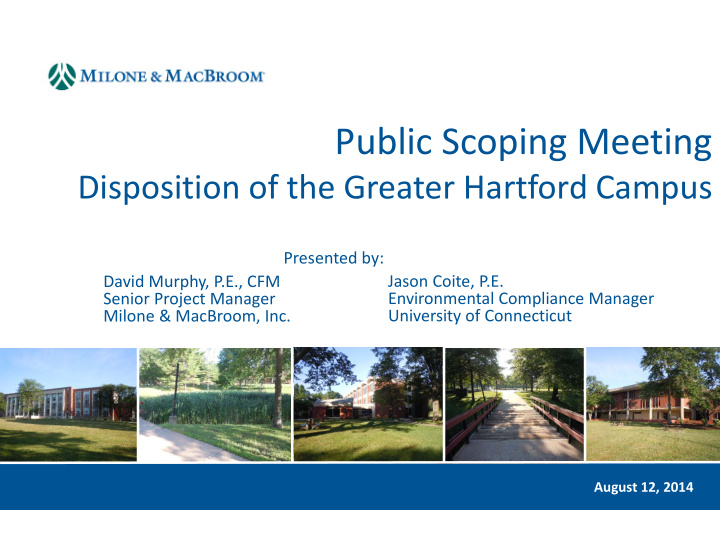



Public Scoping Meeting Disposition of the Greater Hartford Campus Presented by: David Murphy, P.E., CFM Jason Coite, P.E. Senior Project Manager Environmental Compliance Manager University of Connecticut Milone & MacBroom, Inc. August 12, 2014
Purpose of Scoping Meeting Provide background information on the Connecticut Environmental Policy Act (CEPA) and the project Present the project scope and objectives Describe the local, regional, and state plans and the environmental conditions that will frame the evaluation under CEPA Provide information relative to the overall schedule and future efforts of the project Provide a forum for gathering input Understand the areas of public interest and identify questions to be answered 2
What is CEPA? 1. A State act that applies to certain publicly funded projects. 2. A process of evaluating environmental impacts through an Environmental Impact Evaluation (EIE) such that they can be avoided, minimized, and mitigated. 3. Provides a mechanism for early planning and coordination among interested parties, including the public at large. 3
CEPA Components Define Project Purpose and Need Evaluate Alternatives Define Affected Environment and Existing Local, Regional, and State Plans Evaluate Potential Impacts Identify Mitigation for Unavoidable Impacts Incorporate Public Input 4
Project Purpose and Need Cease operations at the campus located in West Hartford Allow for reuse or redevelopment by an entity other than UConn Relocation of the campus operations to the downtown Hartford site is not part of the project; this has been addressed separately 5
Description of Existing Site and Facilities Area is 58 acres Harleigh B. Tracker Library School of Social Work Undergraduate building Information Technology Center Facilities Operations building Parking for 1,050 vehicles Ball fields leased by the Town for Little League, etc. Serves approximately 1,400 undergraduate and 1,520 full- and part-time graduate students Approximately 410 faculty and other affiliated or non-affiliated staff 6
Alternatives to Evaluate 1. Demolition of campus improvements 2. Stabilizing and securing campus buildings and grounds (“mothballing”) 3. Reuse by an institute of higher education 4. Reuse and/or redevelopment by a state agency or municipality 5. Redevelopment for commercial and/or residential use 6. No action (remains an active UConn campus) 7
Impact Analysis Physical Natural Socioeconomic • Air Air Q Quali lity • Geology, T Topograp raphy & y & • Land Use & e & Zonin ing Soils ils • Noise & & Light • State, L St Loca cal & & Ca Camp mpus • Surface Water er R Res esources Master P Pla lanning • Traffic, P Parking & & Circula lation • Grou oundwater R Resou ources • Open pen S Spa pace e & Farmla land • Public lic U Utili ilitie ies • Floodpla plain ins • Public lic H Healt lth & & Safety • Potable W Water er Suppl pply • Wetla lands • Economy, E Employm yment & Income • Stormwat ater D r Drai rainage • Fisheries • Envir ironmen ental J l Justic ice • Solid & & Hazardo dous • Pla lants & & Wild ildlife/ S State Waste Lis isted S Spec pecies • Communit ity Facilit lities & ies & Service ces • Aest sthet etic ic R Resources es • Specimen Tr Trees • Cultural Re Cu Resources Source: UConn 8
Existing Local, Regional, and State Plans State Conservation and Development Policies Plan 2013-2018 Entire site is within Priority Funding Area (PFA) Conservation Areas are associated with wetlands and flood zones Balanced PFAs are mapped where they overlap GIS files provided by CT OPM 9
Existing Local, Regional, and State Plans Capital Region Council of Governments Regional Plan, 2009 “Higher Intensity Development Area” Image courtesy of CRCOG Regional Plan 10
Existing Local, Regional, and State Plans West Hartford Plan of Conservation and Development, 2009-2019 Consider socioeconomic linkages with the Bishop's Corner neighborhood Consider linkages to surrounding residential areas and recreational resources 11
Affected Environment Floodplains and Floodway Flood risk zones mainly associated with tributaries of Trout Brook Stream is partly contained in culverts GIS files provided by FEMA 12
Affected Environment Wetlands and Wildlife Wetlands present Threatened and endangered species are not listed for the site or vicinity GIS files provided by CT DEEP 13
Affected Environment Hazardous Building Materials, Waste, and Other Hazardous Materials Asbestos containing building materials Other materials and fluids presently or formerly on site: Diesel oil Elevator hydraulic oil Gasoline tanks (removed) Fuel oil tanks (removed) 14
Potential Mitigation for Impacts Appropriately remove and dispose of hazardous materials and hazardous building materials that may be found Avoid direct impacts to wetlands Avoid filling or development in floodplains Support local plans for West Hartford and the Bishop’s Corner neighborhood Provide mitigation for adverse traffic impacts Avoid overburdening town services 15
Next Steps Review public and State Agency comments received tonight and before the deadline of August 17, 2014 Determine one of the following: o Proceed to EIE per CEPA o EIE not necessary per CEPA o Postpone determination to a later date Subsequent steps to be determined based on identification of a preferred alternative 16
Comments & Questions Comments and questions regarding the project and/or the CEPA process may be directed to: Jason Coite, P.E. Environmental Compliance Manager University of Connecticut 31 LeDoyt Road Storrs, CT Phone: 860-486-9305 Fax: 860-486-5477 E-Mail: jason.coite@uconn.edu Deadline for Written Comments is August 17, 2014 Verbal comments are welcome tonight 17
UConn Websites UConn Office of Environmental Policy http://www.envpolicy.uconn.edu/eie.html UConn Planning, Architecture and Engineering Services http://paes.uconn.edu/GHCDisposition.html 18
Recommend
More recommend